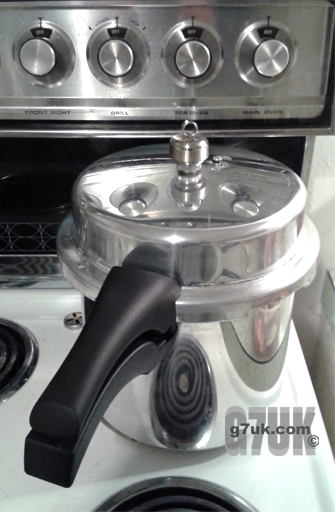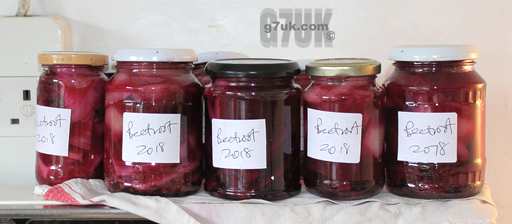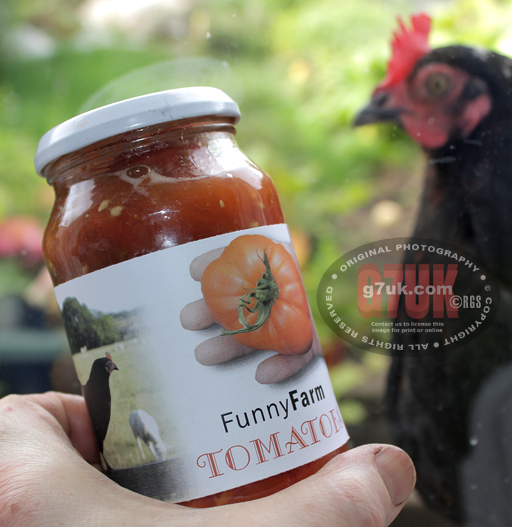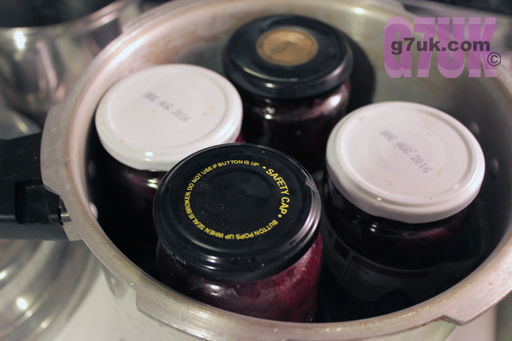A couple of years ago I bought a pressure cooker. I got it direct from the manufacturers Prestige (I have no connection with them) and opted for the 6 litre high dome model. Currently that’s on offer from them for £45 and, barring a really exceptional special offer somewhere, I doubt you’ll find it for much less.

Seen here on my classic 1970s Creda Carefree cooker.
This was a bit of step into the unknown for me as I didn’t grow up in a pressure-cooker-using family, In fact growing up in the north-east I can’t remember ever seeing one. Were they perceived as being a bit middle-class and southern?
So they remained mysterious hissing things. A bit frightening, perhaps even dangerous? There were those rumours of food on ceilings…
The main benefit of the pressure cooker is that on average it cuts cooking time to about one third of the usual. The cooker has a lid which locks in place. A weight on the top increases the atmospheric pressure inside and that raises the temperature at which the liquid boils. The weight is adjustable to 5 pounds, 10 pounds or 15 pounds. But 15 is used for most things.
There’s a myth that the higher temperature leads to food being boiled to oblivion and ending up tasteless. But that hasn’t been my experience. Everything’s delicious. I suppose because the cooking time is so much shorter? And contrary to what you might expect the kitchen seems far less steamy than usual.
These days the cookers have various safety features. The lid can’t be removed until the pressure reduces to normal. There’s a safety plug on top of the lid which would melt and release the steam if the top vent became blocked and a hole in the rim of the lid which would do the same. But that is very unlikely to happen unless the cooker is overloaded with something that froths up.
The procedure for using the pressure cooker is always much the same. Put things in, there always has to be a certain amount of liquid. Put on the lid and turn up the heat to full. As the water boils the safety plug pops up.
After about another 90 seconds the pressure begins to raise the weight on top and steam hisses from the vent. That means the correct pressure has been reached and it’s time to turn down the temperature of the cooking ring to maintain that slight hissing throughout the cooking time.
I cook soups, curries, pasta sauces, chilli-con-carne and I particularly like to pot roast a joint of beef. That can be cooked from frozen and takes just 22 minutes per pound for topside, 25 minutes for silverside and 30 minutes for brisket. If the joint is fresh or thawed beforehand the times per pound are 12, 20 and 15 minutes.

When it comes to vegetables, the pressure cooker is particularly good for my home grown beetroot as the lengthy cooking time is reduced down to between 10 and 30 minutes depending on the size. For other vegetables such as potatoes the time is so short at 4 minutes that it can be difficult to get them exactly right.
Unlike a normal pan you can’t lift the lid to check on progress. You have to reduce the pressure first. For most things that means putting the pan under the cold water tap for a few seconds. Then the lid can be unlocked.
However, in the case of some things such as rice and pasta, which may froth up, the cooker has to be left off the heat until the pressure subsides by itself. I find it takes so long that it isn’t much of a time saving.
The pressure cooker is terrific for pulses. Dried beans and peas only have to be soaked for an hour before cooking. The cooking time for chickpeas is 20 minutes and just 10 minutes for black eye beans or red kidney beans. Suddenly it becomes much more practical to use these. No more soaking overnight…
Making stock is less of a chore too as the usual cooking time is reduced by two-thirds. So perhaps 15 minutes for vegetable stock and 45 minutes for meat stock.

One of my hens looks through the kitchen window at herself on a label made for fun.
I bought the high dome model because jars fit into it. I use it to preserve home grown pickled beetroot and tomatoes.
The tomatoes are packed into jars with some salt and a teaspoon of lemon juice in each (to increase acidity) and the lids are screwed on. They’re processed in the cooker with the 5 pound weight for 15 minutes after which the pressure is allowed to subside naturally. Once out, as the temperature of the jar reduces, the lids “pop down” creating a seal. They can be stored in the cupboard almost indefinitely like any jar from the shops.
There’s no need to buy expensive jars and lids for this bottling (or canning as the Americans call it). You can reuse any from the supermarket. From jams, pickles, pesto, olives… The lids can be used several times (ask family and neighbours to keep them for you) and the glass jars potentially forever. Lids come in a handful of different sizes and should have the dimple on top so you can confirm that they “pop down” and seal correctly as they cool.

There’s an ongoing running cost with the pressure cooker. That’s the gasket — the black rubber seal that fits inside the lid. If you use the cooker quite a bit that will need to be replaced every 12-18 months. A genuine Prestige replacement gasket costs about £5 on eBay.
However there’s also a saving in terms of energy used during cooking. That’s cut to about one third, which should more than cancel out the ongoing cost of the gasket.
My only criticism of the Prestige 6L high-dome is a minor one. Being made of aluminium, it does tend to scratch easily. But I have no regrets buying it.
The huge time saving when using a pressure cooker transforms what you can get done in the kitchen in a morning or afternoon, particularly if you like to freeze meals, cook pulses and stock for future use.

